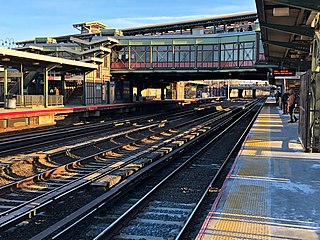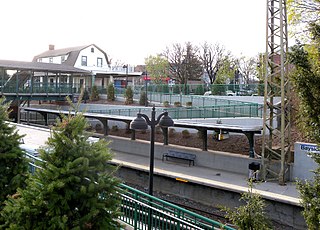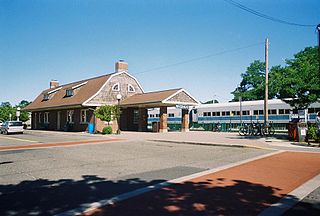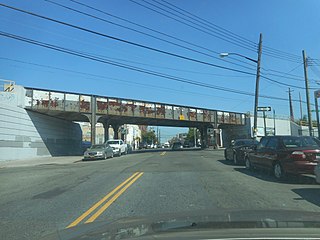
The Jamaica station is a major train station of the Long Island Rail Road located in Jamaica, Queens, New York City. With weekday ridership exceeding 200,000 passengers, it is the largest transit hub on Long Island, the fourth-busiest rail station in North America, and the second-busiest station that exclusively serves commuter traffic. It is the third-busiest rail hub in the New York area, behind Penn Station and Grand Central Terminal. Over 1,000 trains pass through each day, the fourth-most in the New York area behind Penn Station, Grand Central Terminal, and Secaucus Junction.

The Atlantic Terminal is the westernmost commuter rail terminal on the Long Island Rail Road's (LIRR) Atlantic Branch, located at Flatbush Avenue and Atlantic Avenue in Downtown Brooklyn, New York City. It is the primary terminal for the West Hempstead Branch, and a peak-hour terminal for some trains on the Hempstead Branch, Far Rockaway Branch, and the Babylon Branch; most other service is provided by frequent shuttles to Jamaica station. The terminal is located in the City Terminal Zone, the LIRR's Zone 1, and thus part of the CityTicket program.

Englewood Station or Englewood Union Station in Chicago, Illinois' south side Englewood neighborhood was a crucial junction and passenger depot for three railroads – the Chicago, Rock Island and Pacific Railroad, the New York Central Railroad, and the Pennsylvania Railroad – although it was for the eastbound streamliners of the latter two that the station was truly famous. Englewood Station also served passenger trains of the New York, Chicago and St. Louis Railroad, which operated over the New York Central via trackage rights. The station closed in 1978 when the Rock Island closed intercity rail operations and intermediate stops between LaSalle Street and Gresham. There are presently no plans to reopen the station.

The Woodside station is a station on the Main Line and Port Washington Branch of the Long Island Rail Road (LIRR), located in the Woodside neighborhood of Queens in New York City. It is the first station passed by eastward trains from Penn Station and Grand Central Madison, and it is the only station in Queens shared by the Port Washington Branch and other LIRR branches. East of Woodside the two-track Port Washington Branch turns northeastward, while the four-track Main Line continues southeast to Jamaica station.

Bayside is a station on the Long Island Rail Road's Port Washington Branch in the Bayside neighborhood of Queens, New York City. The station is located at 213th Street and 41st Avenue, off Bell Boulevard and just north of Northern Boulevard, and is 12.6 miles (20.3 km) from Penn Station in Midtown Manhattan. The station is part of CityTicket.

Westbury is a station on the Long Island Rail Road's Main Line. All trains for the Port Jefferson Branch and Ronkonkoma Branch run through it, though only some trains on the Port Jefferson branch stop. It is located at Union and Post Avenues in Westbury, New York. It is 23.4 miles (37.7 km) from Penn Station. The station is fully wheelchair accessible. It has two side platforms and three tracks.

Sayville is a station on the Montauk Branch of the Long Island Rail Road in the hamlet of Sayville, New York, on Depot Street between Greeley Avenue and Railroad Avenue. Ferries to Fire Island board from a port south of the station.

Dunton was a ground-level station on the Long Island Rail Road's Montauk Branch, Atlantic Branch, and later the Main Line in Dunton, Queens, New York City, United States. It was closed in 1939 when the Atlantic Branch was placed in a tunnel east of East New York.

Riverhead is a station along the Main Line of the Long Island Rail Road. It is located on Osborne Avenue and Railroad Street in Riverhead, New York, north of NY 25 and the Suffolk County Court House.

St. Cloud station is an Amtrak intercity train station in St. Cloud, Minnesota, United States. It is served by the daily Empire Builder on its route connecting Chicago, Illinois to Seattle, Washington and Portland, Oregon. The next stop westbound is Staples while the next stop eastbound is Saint Paul Union Depot.

Locust Valley is a station on the Oyster Bay Branch of the Long Island Rail Road. It is located at Birch Hill Road and Piping Rock Road, south of Forest Avenue, in Locust Valley, Nassau County, New York.

Bay Shore is a major railroad station on the Montauk Branch of the Long Island Rail Road (LIRR), on Park Avenue and Oak Street north of Suffolk CR 50 and west of Fourth Avenue, in Bay Shore, New York. Ferries to Fire Island board from a port south of the station.

Oakdale is a railroad station on the Montauk Branch of the Long Island Rail Road, on the corner of Oakdale-Bohemia Road and Montauk Boulevard in view of Montauk Highway across Norman DeMott Park, in Oakdale, New York.
Bellaire was a station stop along the Hempstead Branch of the Long Island Rail Road. The station was located between 211th Street and 212th Street between 99th Avenue and Jamaica Avenue in Bellaire, Queens.

Setauket was a station stop along the Port Jefferson Branch of the Long Island Rail Road. The station was located on the north side of the tracks just east of the bridge where Gnarled Hollow Road passes under the tracks in East Setauket. Access to the station was through a driveway which emptied onto Gnarled Hollow Road just north of the bridge on the east side of the road. The station opened in July 1873, and closed on June 27, 1980.

Corona was a station along the Port Washington Branch of the Long Island Rail Road in the Corona section of Queens, New York City. It was one of two stations built by the Flushing Railroad in Corona, this one having been at Grand Avenue and 45th Avenue. The station first opened as Fashion Race Course in March 1855. It was then renamed West Flushing, once the West Flushing station at 108th Street closed, and possibly when the race track was closed in 1869, and later renamed Corona around June 1872 when the Post Office was opened under the name of Corona. The race pens were located on this street which led directly north to the Fashion Race Course.
Higbie Avenue was a railroad station along the Atlantic Branch of the Long Island Rail Road, in Queens, New York City. The station was located on 140th Avenue and Edgewood Avenue in the Springfield section of Queens, New York City between Locust Manor and Laurelton stations.

East Moriches is a former railroad station on the Montauk Branch of the Long Island Rail Road. It was located near Pine Street and Railroad Avenue in East Moriches, New York.

Jamesport was a station stop along the Greenport Branch of the Long Island Rail Road in Jamesport, New York. Jamesport's original name was James' Port from the community a mile south of the railroad.

The Cannonball is a seasonal named train operated by the Long Island Rail Road between Penn Station in New York City and Montauk on the east end of Long Island, New York. The train operates weekly between Memorial Day and Labor Day weekend, operating eastbound on Fridays and westbound on Sundays, with westbound service also being offered through Columbus Day weekend. The train utilizes dual-mode DM30AC locomotives and C3 coaches, the same rolling stock as other LIRR diesel and dual-mode trains, and takes slightly less than three hours to travel the 118-mile (190 km) route.


















